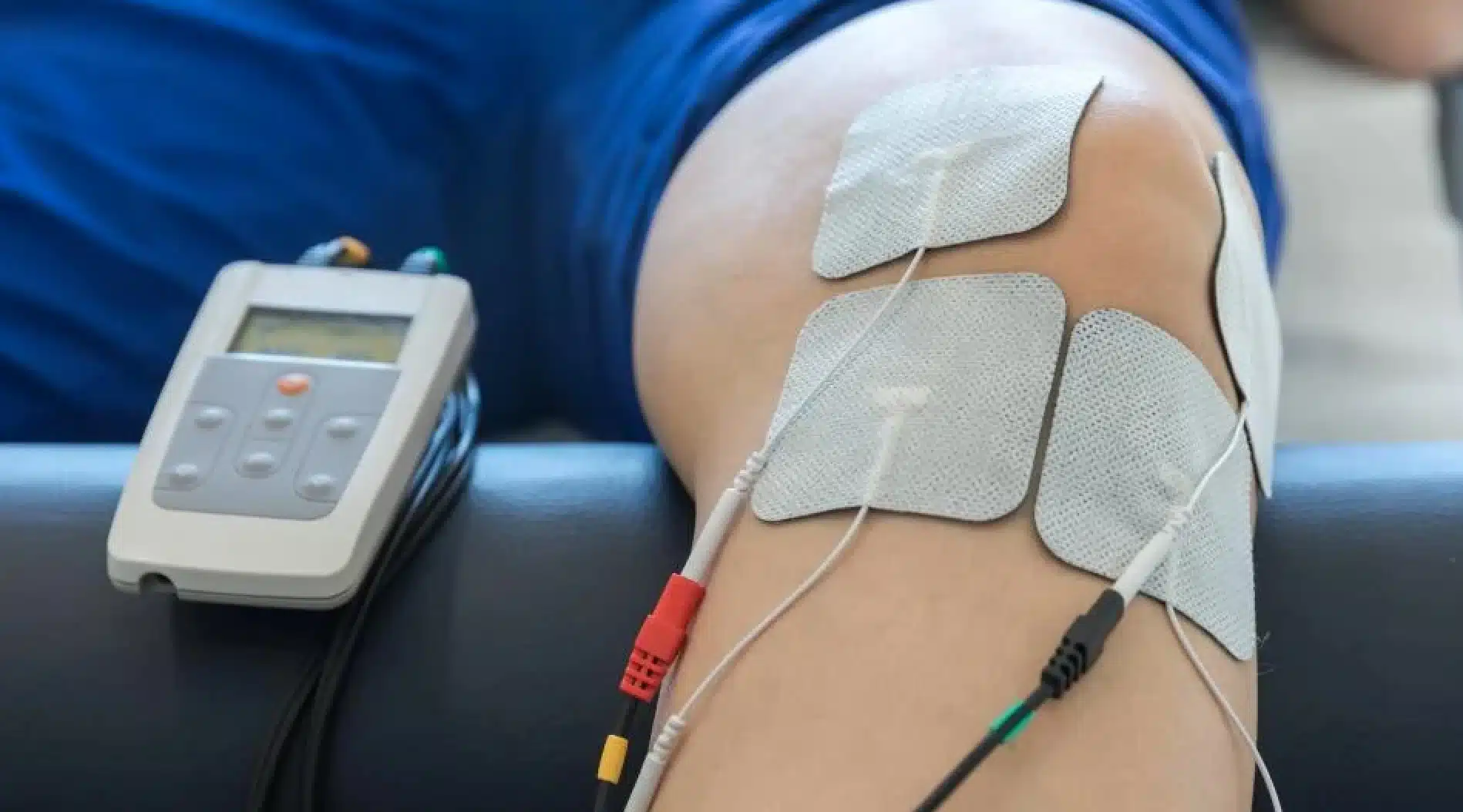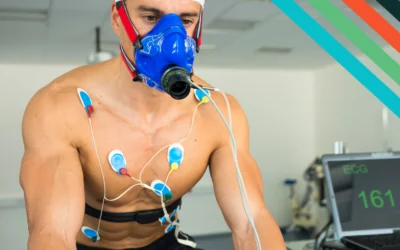Quick Navigation
- Introduction
- What is the Anaerobic Threshold?
- How to find the Anaerobic Threshold?
- Do all sports train the Anaerobic system?
- What is the difference between Anaerobic Threshold, MLSS, and CP?
- How can we track changes over time?
- How much is the Anaerobic Threshold supposed to change over time?
- What types of workouts can I do to improve my anaerobic threshold?
- Health Benefits of Anaerobic Training
- Sample Anaerobic threshold workouts!
- Conclusion
- Additional resources
- References
Introduction
In today’s fast-paced world, finding time to hit the gym can be a challenge.
What if shocking your muscles with electricity helped them get stronger faster?
What if you could get a full-body workout in just 20 minutes?
What if this new method stopped your back from hurting?
What if you could reduce the amount of time you needed to workout by 2/3 and still get great results?
These are the claims of the new full body electrical muscle stimulation (EMS) training and is why there’s so much hype around the topic right now. It sounds too good to be true and people are pumped!
You might have seen EMS units before, in physio clinics. Yes, those small little walkman-type “stim units” with the sticky circular pads that attach to your skin and zap your muscles to elicit a contraction on the muscle below the surface. Essentially, EMS training is that, but while wearing a full-body “stim unit” and while doing a few basic exercises while you get shocked.

You might have actually had good results from EMS at a physio clinic before – so it seems pretty legit, right? On the other hand, the best medicine is exercise (yes, it even wins out over these EMS units – reference Deyo et al 1990). So, should they be trusted at all?
You also might have seen these EMS training classes popping up in your area. In the city of Calgary where I reside, I know of 2 that just popped up this year.
So, I decided to do a deep dive into what EMS is, how it works, the main differences between EMS and regular training, along with safety considerations, all while looking at what science has to say about its effectiveness. Lastly, I’ll give my own critical thoughts on EMS training, coming from a High Performance Exercise Physiologist – and give my 2 cents from someone who trains individuals and athletes for a living!
Let’s go! And if you have any additional questions once you’ve made it through this whole article, drop me a line HERE and we can keep the convo going.
What does EMS Training look like?
Here’s a quick video I found on Rachel Ray’s Youtube of a sample video of and EMS training workout:
How EMS Training Works
EMS training works by using electrical impulses to stimulate your muscles. During an EMS workout, you wear a special suit or electrodes that are placed on specific muscle groups. These electrodes send electrical impulses to your muscles, causing them to contract and relax, simulating the same effect as traditional exercise.
The caveat is that an EMS training workout isn’t as passive as you might think. Unlike in a physio clinic where you get to lay on a table while the physiotherapist stimulates your muscles while you remain relaxed, this new class-based EMS training requires you to do exercises while wearing the added stimulation from the suit.
The exercises are usually very basic ones with limited ranges of motion (a half depth bodyweight squat, for example), and the added stimulation makes the workout feel harder, while also taking less time than what you might do traditionally in the gym or another workout class.
It activates more muscle fibers than what you could get if you were doing the same exercises without the suits, but be cautioned that that doesn’t mean you can’t just activate more muscle fibers by using traditional principles of training, without the suits help (more later).
Does EMS Training Improve Muscle growth/strength/recovery?
Yes, EMS training has been shown to improve muscle growth, muscle strength, and recovery.
First, EMS training can improve muscle growth, also known as hypertrophy. The electrical impulses delivered during an EMS workout activate a higher percentage of muscle fibers than exercise without the added activation. BUT, it is still unclear in the literature if this leads to increased muscle activation and growth compared to without the added artificial activation.
Second, EMS training can also improve muscle strength. The electrical impulses delivered during an EMS workout cause muscle contractions that can help to strengthen your muscles. As a result, you can see improvements in your strength and endurance over time. But again, the mechanisms seem to be that you can add muscle strength because you are doing strength-based exercise, not because the suit drives more strength gains in some way.
Finally, EMS training can improve recovery times. The electrical impulses delivered during an EMS workout help to increase blood flow and circulation to your muscles, leading to quicker recovery times and reduced muscle soreness. Funny enough, these are the exact benefits of doing regular exercise activities, too. Even just going for a light walk can increase blood flow and circulation enough to help you recover from muscle soreness or hard exercise.
Overall, EMS training can be an effective way to improve muscle growth, muscle strength, and recovery times… COMPARED TO DOING NOTHING. But, the way it is currently used and marketed does not make me want to run out and buy anything just yet. Continue reading to find out why.
The Main difference between EMS Training and Regular Training
A lot of the companies that sell EMS training are claiming crazy and grandiose things like:
- You can save 4.5x the amount of time you’re currently spending on workouts
- You can burn 3000-4000 calories more in the 48 hours post-exercise, than traditional training
- You don’t even have to get your heart rate high to get these benefits! Even a low heart rate of 120-130 bpm during your workout compared to the high heart rates in traditional training can suffice.
….with no evidence, articles, or links to back these claims up. So I went digging for my own evidence. What actually is the difference between EMS Training and regular or traditional strength training?
In one study by Filipovic et al (2012), they did a systematic review (basically a study of studies to combine results and see if overall there is more of a training effect when using EMS) and they found that with respect to the comparison of conventional strength training and combination with EMS training on enhancing strength abilities, both methods enhanced strength equally. With respect to the results, they couldn’t state that combination EMS was more effective than conventional strength training – and this was a study in trained and elite athletes. Athletes and well-trained individuals are a demographic that already has training experience (duh), and so compared to a study about an untrained person doing EMS training and seeing benefits (duh), this review was a little more legit and more in line with other research in the area (Wilmore, 2022; Berryman, 2010).
There are some studies of these types of untrained individuals getting benefits from EMS training, but only in comparison to a control group, so I also file that in the duh column because to me it’s obvious that it’s the exercise, and not the EMS per se, that’s causing the benefits.
The 7 training principles that are tried, tested, and true in the world of strength and conditioning are these: Specificity, Overload, Adaptation, Individuality, Progression, Recovery and Reversibility. So, I think people can get benefits from a wide variety of types of exercises if they align with these training principles. Do I think that electrical muscle stimulation training is the best way to hit on the principle of specificity of training? I mean – maybe if you’re also working on competing in an event that makes you wear an EMS suit?
Overall, following simple and foundational training principles is likely still the best way to get stronger, fitter, and healthier. Next, let’s debunk some of the main flashy claims about EMS training.
Debunking their claims
EMS training websites have so many unfounded claims that I lost count when doing the research for this post. Here’s 4 common ones I’ll debunk:
- Claim 1: You can work out in 2/3 of the time and get even better strength, more muscle and more recovery
Finding: While it is true that EMS training can activate a higher percentage of muscle fibers than without the stimulation, it is not a replacement for traditional exercise, and typically needs to be combined WITH traditional exercise (hence EMS training classes) in order to get the results we’re after. Some studies have shown that EMS training alone may not be as effective as traditional resistance training in terms of building strength and muscle size while others have shown no difference between the two (Deley et al, 2005; Filipovic et al, 2012). - Claim 2: You can burn up to 1200 calories post workout and another 3000-4000 more calories in the next 48 hours compared to 400 calories and 0 calories in traditional training
Finding: I could not find any evidence of this. There is a term in the research world called EPOC (exercise post oxygen consumption) where researchers measure the amount of oxygen people consume in the hours and days AFTER a hard workout as a proxy for how much energy was burned. But, even when super high intensity training is performed, and even if there is a slight EPOC advantage or additional calorie burn in the days after training, it doesn’t appear to result in additional weight loss or body composition change, something that would in theory be the exact target of this claim. Checkout the article in the reference section by Blaine (2019) called “EPOC: Is it real? Does it matter?” - Claim 3: Your deep muscle tissue growth speed is up to 5x faster with EMS training compared to traditional training
Finding: The claim that EMS training is far superior to traditional training is a bold statement that is not supported by scientific evidence. While EMS training can be an effective way to improve muscle strength and recovery (compared to doing NOTHING), there is no research to suggest that it leads to significantly faster muscle growth compared to traditional strength training.
Muscle growth is primarily driven by progressive overload, which means gradually increasing the weight or resistance used in strength training over time. While EMS training can provide a high level of muscle activation, it may not be enough to stimulate the same level of muscle growth as traditional strength training.
Furthermore, the intensity of EMS training is typically limited by safety considerations, as too much electrical stimulation can lead to muscle damage or other safety concerns. We need more progressive in the principle of progressive overload! This means that, while EMS training can provide an effective workout, it may not be enough to stimulate the same level of muscle growth as traditional strength training. - Claim 4: You can always aid in the recovery of injuries with EMS training versus never in traditional training where you are not with a physiologist.
Finding: The claim that you can always aid in the recovery of injuries with EMS training versus never in traditional training is a sweeping statement that is not entirely accurate.
While EMS training is typically used in a physiotherapy clinic setting to help drive more activation to certain muscle groups when someone is injured or in pain, there’s no convincing evidence that when the stimulation is turned way up, and placed all over your whole body, that that is better than regular exercise.
There are more outlandish claims available but I kept with the craziest ones so that this blog post didn’t turn into a book!
Safety Considerations for EMS Training
While EMS training can make you feel like you’re getting a workout, there are several safety concerns that should be considered before starting this type of training. Some of the main safety concerns associated with EMS training include:
- Electrical safety: EMS training involves the use of electrical impulses to stimulate the muscles. As such, it is important to ensure that the equipment being used is properly maintained and that the user is not exposed to excessive or harmful levels of electrical current. I suppose there could be potential electrical hazards of working with the tech equipment, or in making sure the equipment is properly maintained.
- Risk of injury: As with any type of physical activity, there is a risk of injury with EMS training. In particular, there is a risk of muscle strains and other injuries if the training is not performed properly or if the equipment is not adjusted correctly. This is JUST LIKE going to a bad CrossFit class for the first time and getting your ass handed to you (sorry for the language) with a workout that is way above your abilities. Aside from the really harmful possibility of developing a condition like Rhabdomyolysis from training too hard (that could land you in the hospital), even on a smaller scale, not performing exercises correctly can lead to tendon, muscle, or even bony injury if done poorly. My suggestion is to always work with a qualified trainer who can provide guidance on proper form and technique, and to start with a lower intensity level before gradually increasing the intensity of the workout.
- Medical considerations: EMS training may not be suitable for everyone, particularly those with certain medical conditions such as pacemakers, epilepsy, or pregnancy. It’s important to consult with a doctor before starting EMS training to ensure that it is safe and appropriate for your individual needs.
- Overuse injuries: As EMS training can provide an intense workout in a shorter amount of time, there is a risk of overuse injuries if the training is not balanced with proper rest and recovery time. It’s important to work with a qualified trainer who can provide guidance on an appropriate training schedule and to listen to your body to avoid overtraining.
Overall, while EMS training could be a modality some choose to use, it’s not one that I would recommend to replace regular training (for reasons I’ll talk about in the next section).
Critical Thoughts about EMS Training
The purpose of this blog was to dive deeper into whole-body electro-myostimulation (known as WB-EMS, and described more simply in this blog as EMS training). EMS training is a fancy way of saying that electrical impulses are used to help improve fitness and health in athletes, healthy individuals, and those who may be unable to perform regular exercise due to illness.
However, using EMS on a single muscle might lead to the over training of that muscle, or muscle damage in higher amounts than would typically be delivered to that muscle if not doing training in such an isolated way. In addition, there’s evidence that other tissues besides muscles, like connective tissues and intracellular structures, can be affected during single-muscle EMS. I worry that the hype around these types of classes could be misleading people to think that isolating the feeling of burning and twitching in the muscles is the best way to get fit. This isn’t always the case though.
A recent meta-analysis (Pano-Rodriguez et al, 2019) questioned the effectiveness of EMS. They stated that:
“Given the limited number of available studies on whole body EMS, the scarce amount of scientific evidence found does not allow definitive conclusions about its effects.”
Plus, there are safety concerns, like the potential for rhabdomyolysis (when CK levels in your body rise and can cause kidney damage) and the fact that it’s contraindicated for patients with implanted electronic devices.
I also worry that we’re not honoring the fact that exercises we perform require a coordination of muscle activations to get proper technique. In the gym, performing a squat requires the contraction of various leg muscles with the subsequent relaxation or lessening of a contraction of muscles on the other side of the joint to allow the movement to occur. Imagine your quads AND hamstrings were maximally activating – but the quads extend the knee and the hamstrings flex the knee – so what would happen? Maybe you would be stuck in a tonic contraction where no movement would occur? It’s just not the way people are supposed to move.So, I’m not totally sold on us stimulating “everything” and expecting good things to come in terms of movement quality, patterns, or motor learning.
My overall beef with EMS training can be summarized neatly here:
- Safety concerns: Many people are concerned about the safety of EMS training, particularly if they have underlying medical conditions, such as heart problems or epilepsy, or if they are pregnant. My immediate concern is not for those with known conditions like these ones listed, but for general people going into these classes, pushing themselves as hard as possible because “it’s only 20 minutes”, and then walking away with rhabdomyolysis and landing themselves in the emergency room.
- Cost: EMS training can be expensive, particularly if it is done through a specialized fitness center or with a personal trainer. This can make it difficult for some people to afford or to justify the cost. Even if you can justify the cost, I just feel like it’s comparable to taking 40x the dose of vitamin C on the back of the bottle and expecting 40x the health benefits. In reality: now you just have expensive pee and a stomach ache!
- Lack of evidence: While there is some research on EMS training, there is still a lack of robust scientific evidence to support its effectiveness for muscle growth and strength. Maybe this will change one day but for now, I won’t be using it.
- Overhyped claims: Many manufacturers and trainers make bold claims about the effectiveness of EMS training, such as faster muscle growth and strength gains than with traditional training. However, these claims are often SUPER exaggerated or not supported by scientific evidence.
- Limited variety of exercises: EMS training typically involves a limited number of exercises that are designed to target specific muscle groups but because the full-body stimulation activates both sides of many joints, it makes the range of motion of the exercises more limited than what we would typically like to see in most people’s training at most times. There are joint and muscle benefits exclusive to training in full ranges of motion, and EMS training ignores this fact.
Conclusion
In conclusion, EMS training is a unique and increasingly popular method of exercise that uses electrical impulses to stimulate muscle contractions. While there is no current research to support that EMS training is any better than traditional training, its marketing claims over-deliver from every perspective. There are also concerns about its safety, its cost, and mostly about its outlandish claims. It’s important to approach EMS training with a critical eye and to carefully consider the potential risks and benefits before starting. As with any type of exercise, it’s important to consult with a healthcare professional before starting a new workout program. Ultimately, the decision to try EMS training should be based on individual needs and preferences, and should be accompanied by a commitment to safe and responsible use.
References
Berryman, J. W. (2010). Exercise is Medicine: A Historical Perspective. In Curr. Sports Med. Rep (Vol. 9, Issue 4). www.acsm-csmr.org
Blaine Arney, by E., Foster, C., & Porcari, J. (2019). EPOC IS IT REAL? DOES IT MATTER? www.acsm-healthfitness.org
Claims about EMS Training; Retrieved from https://www.xfityyc.ca/why-ems-training/ on February 15, 2023.
Deley A-C, G., Lle Kervio, G., Né Dicte Verges, B., Hannequin, A., Petitdant, M.-F., Salmi-Belmihoub, S., Grassi, B., & Casillas, J.-M. (n.d.). Comparison of low-frequency electrical myostimulation and conventional aerobic exercise training in patients with chronic heart failure. https://academic.oup.com/eurjpc/article/12/3/226/5933700
Deyo, R., Walsh, N., Martin, D., Schoenfeld, L., & Ramamurthy, S. (1990). A controlled trial of transcutaneous electrical nerve stimulation (TENS) and exercise for chronic low back pain. New England Journal of Medicine, 322(23), 1627–1635.
Filipovic, A., Kleinoder, H., Kleinoder, K., Dormann, U., Dormann, D., & Mester, J. (2012). ELECTROMYOSTIMULATION-A SYSTEMATIC REVIEW OF THE EFFECTS OF DIFFERENT ELECTROMYOSTIMULATION METHODS ON SELECTED STRENGTH PARAMETERS IN TRAINED AND ELITE ATHLETES. Journal of Strength and Conditioning Research , 26(9), 2600–2615. www.nsca.com
Hauger, A. v., Reiman, M. P., Bjordal, J. M., Sheets, C., Ledbetter, L., & Goode, A. P. (2018). Neuromuscular electrical stimulation is effective in strengthening the quadriceps muscle after anterior cruciate ligament surgery. In Knee Surgery, Sports Traumatology, Arthroscopy (Vol. 26, Issue 2, pp. 399–410). Springer Verlag. https://doi.org/10.1007/s00167-017-4669-5
Innovative Wireless Training – related photography. Retrieved from https://innlineglobal.com/?gclid=Cj0KCQiAorKfBhC0ARIsAHDzsluZwTEXs0chbBF5Y_fxn8yGE557jCT5qlA6fvE07r-h7Uo6ss7NNHkaArzTEALw_wcB on February 15, 2023.
Pano-Rodriguez, A., Beltran-Garrido, J. V., Hernández-González, V., & Reverter-Masia, J. (2019). Effects of whole-body ELECTROMYOSTIMULATION on health and performance: A systematic review. In BMC Complementary and Alternative Medicine (Vol. 19, Issue 1). BioMed Central Ltd. https://doi.org/10.1186/s12906-019-2485-9
Ruby & Hoskin (2022). Best TENS machine 2022. Retrieved from https://www.expertreviews.co.uk/health-and-grooming/1407417/best-tens-machines on February 15, 2023.
Stöllberger, C., & Finsterer, J. (2019). Side effects of and contraindications for whole-body electro-myo-stimulation: A viewpoint. In BMJ Open Sport and Exercise Medicine (Vol. 5, Issue 1). BMJ Publishing Group. https://doi.org/10.1136/bmjsem-2019-000619
Wilmore, J. H. (2003). Aerobic exercise and endurance: Improving fitness for health benefits. In Physician and Sportsmedicine (Vol. 31, Issue 5). McGraw-Hill Companies. https://doi.org/10.3810/psm.2003.05.367
Quick Navigation
- Introduction
- What does EMS Training look like?
- How EMS Training works
- Does EMS Training improve muscle growth/strength/recovery?
- The main difference between EMS Training and Regular Training
- Debunking their claims
- Safety Considerations for EMS Training
- Critical Thoughts about EMS Training
- Conclusion
- References



